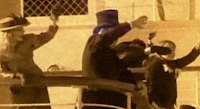The use of sepia as opposed to just plain black and white adds to the emotion given off by the people (real footage often has more of an impact on the viewer than if 'artificial' footage is used). Black and white movies often carry a lot less emotion than a film shot in sepia as sepia provides warmth and a feeling of security to the picture, whereas the b/w picture is very cold, making it more difficult for the viewer to want to be involved.
The shot has been taken from an elevated point over the crowd, but not above the ship. This positioning gives the viewer a third party view of the scene, as opposed to being a first person, in the crowd. By doing this the director is asking the audience not to involve themselves with the people in the shot.
Putting these affects together, the audience gets a happy feeling from the scene as they are able to see the emotion of the people being shot in the scene, a mixture of pride, sadness, and happiness, coupled with the warm tone of the image created by using the sepia effect.
In this scene, the camera pans initially from the bulk of the crowd, lifting slightly as the picture shifts towards the ship, making it the importance of the emotion of the crowd become less, and make the ship then become the greater emotional focus, making it more of and icon than it started off as.
---------------------------------------------------------------------------------------------------------
In the next few shots we are, as the viewer, we are given a set of Point Of View (POV) shots. This allows a further insight into the emotions of the people waving off friends and loved ones. However, there is no camera shake to the picture which makes it a little less personal. This may have been because the footage was first used for more of a documental use, as opposed to a feature film. This was, i expect, the most suitable piece of footage that the director could find that would allow the audience to involve themselves in the event.
---------------------------------------------------------------------------------------------------------
 After the previous picture (above), it fades into this picture of water, swelling around. The main change with this scene change is that colour is brought in.
After the previous picture (above), it fades into this picture of water, swelling around. The main change with this scene change is that colour is brought in.By doing this the director again presents an obvious change in time, as the sepia effect has been lost and full colour now seems to be in use. This tells the audience that they are now viewing in modern day real-time, as opposed to being in the past, watching the ship leave the port.
The other major change is again with the colour. The director has chosen to use dark colours with fairly high contrast, creating a very dark blue effect, but related to a grey scale effect. By using this technique a sinister feeling is made. This feeling is then carried forward in the next scene when a submarine is seen inspecting the sunken ship. (The impact of the warm looking first scenes now is given an even greater impact on the audience as it means that all the joy and high emotion in the crowd has been completely destroyed as almost all of the people on the ship are now dead).
---------------------------------------------------------------------------------------------------------
Throughout the title sequence in Titanic, there is no immediate real-time noise/sound until we get to the submarine scene. This acapella voice (in link) is a very empty piece of music, making a contrast in how the viewer sees the opening sepia images. Even though a warm feeling should be created from the film itself, the cold sounding voice in the background gave an underlying sinister feel to these scenes, being fulfilled in the part where real-time is brought in and the sunken ship is first seen. This effect has been used very powerfully as the audience does feel great sad emotion from these scenes, possibly even to an overwhelming level.





No comments:
Post a Comment